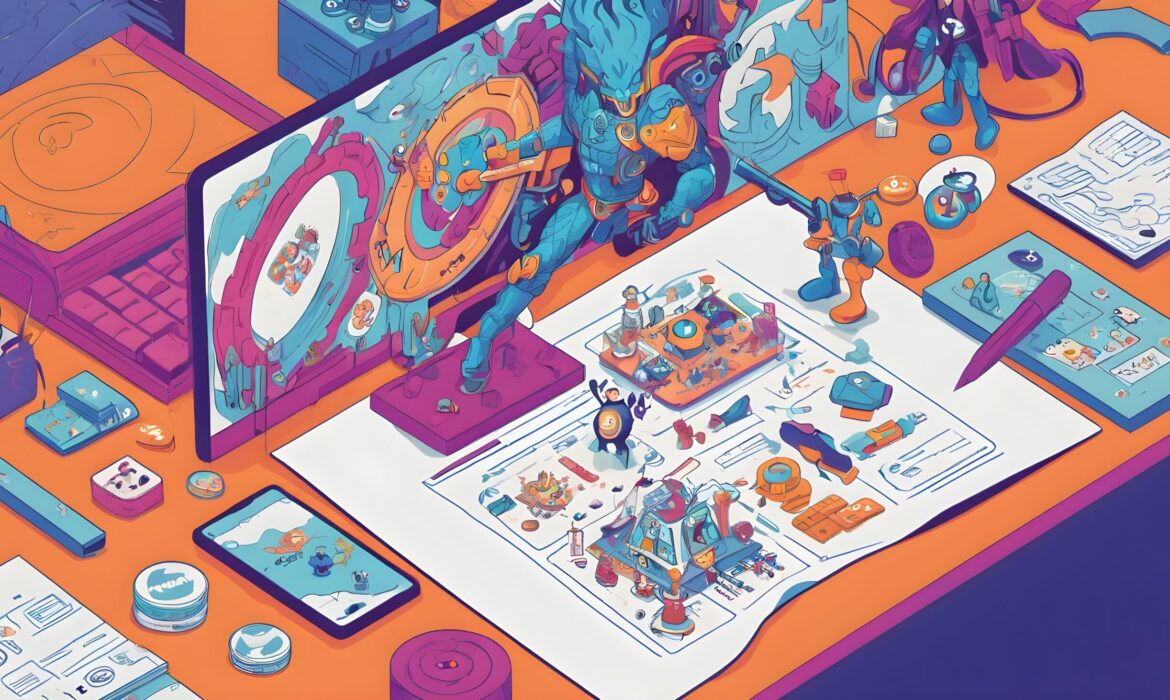081-4797-7173
In today’s fast-paced digital environment, it’s becoming increasingly difficult for marketers to capture and maintain audience attention. Traditional marketing strategies often have difficulty engaging consumers in a meaningful way and result in poor return on investment. This is where gamification comes in. Gamification is a powerful technique that uses game mechanics to increase engagement, increase customer loyalty, and increase brand awareness.
Gamification harnesses the innate human desire for competition, achievement, and reward to turn everyday marketing activities into engaging experiences. By incorporating elements such as points, badges, challenges, and rewards into marketing campaigns, businesses can create interactive, immersive experiences that resonate with their target audience.
This article explores the concept of gamifying your marketing efforts to increase engagement, increase customer interaction, and ultimately achieve your marketing goals.
Understanding Gamification
What is Gamification?
Gamification is the process of integrating game design elements and mechanics into non-game contexts, such as marketing campaigns, to attract and motivate users. These elements typically include points, badges, levels, challenges, leaderboards, and rewards. By applying game design principles, companies can make their marketing efforts more interactive, immersive, and fun for their target audience.
Gamification is based on the idea that people are naturally drawn to games and enjoy the challenge, competition, and rewards. By incorporating gaming elements into their marketing strategies, companies can leverage these intrinsic motivations to drive desired behaviors such as increased engagement, brand loyalty, and conversions.
Psychology Behind Gamification
The effectiveness of gamification lies in its ability to appeal to fundamental psychological principles. For example:
- Intrinsic Motivation: Games are powerful motivators, giving users autonomy, mastery, and a sense of purpose. Gamification taps into the intrinsic motivation for success by giving users the opportunity to overcome challenges and achieve goals.
- Social Influence: Humans are social creatures by nature and are influenced by the actions and actions of others. Gamification uses social elements such as leaderboards, challenges, and community features to encourage competition, collaboration, and social interaction among users.
- Rewards and Reinforcement: Gamification uses rewards such as points, badges, and virtual currency to reinforce desired behaviors. These rewards activate the brain’s pleasure centers, leading to a sense of accomplishment and satisfaction, motivating users to continue the experience.
Benefits of Gamification in Marketing
- Increased Engagement: Gamification makes your marketing efforts more interactive and interesting, attracting and retaining your users’ attention for a longer period of time. By offering users challenges, rewards, and incentives, businesses can create engaging experiences that keep users coming back.
- Enhanced Brand Loyalty: Gamification fosters a sense of connection and loyalty between users and brands by rewarding and recognizing their engagement and loyalty. By offering exclusive rewards, discounts, or access to premium content, businesses can incentivize users to remain loyal to their brand.
- Improved Data Collection and Insights: Gamification allows businesses to collect valuable data about user behavior, preferences, and interactions. By tracking user progress, engagement levels, and performance, businesses can gain insights into their target audience’s interests and preferences, enabling them to optimize their marketing strategies accordingly.
- Increased Conversions and Sales: Gamification can drive conversions and sales by incentivizing users to take desired actions, such as making a purchase, signing up for a newsletter, or sharing content with their social networks. By offering rewards or discounts for completing these actions, businesses can motivate users to move further down the sales funnel.
Gamification Techniques in Marketing
Points, Badges, and Leaderboards (PBL)
Points, Badges, and Leaderboards (PBL) are classic gamification elements that leverage users’ intrinsic motivation to achieve goals and earn recognition. Points are awarded to users for completing certain actions or reaching milestones, and badges serve as visual symbols of accomplishment. Leaderboards display user rankings based on points and achievements, fostering competition and encouraging users to aim for the top spot.
Implementing PBL to encourage desired behavior, such as making a purchase, referring a friend, or overcoming a challenge. For example, an e-commerce site might reward customers with points for every purchase and unlock badges when they reach certain spending milestones. Leaderboards can showcase your top customers and brand advocates, foster competition, and encourage others to increase engagement with your brand.
Challenges and Rewards
Challenges and rewards are effective gamification techniques to engage users and encourage them to take specific actions. Challenges present users with tasks or goals to complete within a set time frame, and rewards provide an incentive for successful completion. These rewards can take many forms, including discounts, exclusive access to content and events, and virtual currency.
In marketing, challenges and rewards can be used to drive user engagement, promote brand loyalty, and encourage desired behaviors. For example, a fitness app might require users to complete a certain number of workouts per month and receive rewards, such as premium features or products, when they meet their goals. By offering tangible rewards for overcoming challenges, companies can give viewers a sense of accomplishment and satisfaction and encourage further participation.
Interactive Content and Quizzes
Interactive content and quizzes are engaging gamification techniques that encourage user participation and interaction. Interactive content allows users to actively engage with marketing materials, such as videos, infographics, or interactive ads, while quizzes challenge users to test their knowledge or skills on a particular topic.
In marketing, interactive content and quizzes can be used to educate, entertain, and engage users, driving brand awareness and affinity. For example, a beauty brand may create an interactive quiz to help users discover their ideal skincare routine, with personalized product recommendations based on their quiz responses. By providing valuable and entertaining content in an interactive format, businesses can capture and hold users’ attention, increasing brand recall and engagement.
Augmented Reality (AR) and Virtual Reality (VR) Experiences
Augmented reality (AR) and virtual reality (VR) technologies offer immersive gamification experiences that blur the line between the digital and physical worlds. AR overlays digital content onto the real world through a smartphone or tablet camera, while VR creates entirely virtual environments using specialized headsets.
In marketing, AR and VR experiences can create memorable and interactive brand experiences that captivate users and leave a lasting impression. For example, a furniture retailer may offer an AR app that allows users to visualize how different pieces of furniture would look in their home before making a purchase. By leveraging AR and VR technologies, businesses can create immersive storytelling experiences, showcase products in a unique way, and drive engagement and brand affinity among their audience.
Implementing Gamification Strategies
Identifying Target Audience and Goals
The first step in implementing a gamification strategy is to identify your target audience and define clear goals for your gamification marketing efforts. Knowing your audience’s demographics, interests, and motivations can help you tailor your gamification approach to effectively resonate with your audience. Additionally, clearly defining your goals, such as increasing brand awareness, driving user engagement, and increasing sales, will give you a roadmap for designing and measuring the success of your gamification efforts.
Choosing the Right Gamification Tools and Platforms
Once you have identified your target audience and goals, the next step is to choose the right gamification tools and platforms to execute your strategy. There are a variety of gamification platforms and software solutions available, ranging from turnkey solutions to custom-built applications. Consider factors such as ease of use, scalability, and compatibility with your existing marketing stack when selecting a gamification platform. Additionally, ensure that the chosen tools align with your budget and technical capabilities.
Designing Engaging Game Mechanics
Designing engaging game mechanics is key to providing an engaging and rewarding gamification experience for your audience. Game mechanics refer to the rules, challenges, and rewards that encourage user engagement and progression within a gamified system. Common game mechanics include points, badges, leaderboards, challenges, rewards, and progression systems. When designing game mechanics, consider factors such as simplicity, transparency, and balance to ensure a positive user experience. Test different mechanisms and iterate based on user feedback to optimize engagement and effectiveness.
Integrating Gamification with Marketing Campaigns
Integrating gamification into your marketing campaigns requires seamlessly integrating gamification elements into your existing marketing channels and efforts. When adding gamification features to your website, mobile app, social media campaigns, or email marketing efforts, the key is to create a consistent, integrated experience for your audience. Use gamification to encourage desired behaviors, increase user engagement, and increase the reach and effectiveness of your marketing campaigns. Monitor and analyze the performance of your gamification efforts and adjust your strategy as needed to maximize results and achieve your marketing goals.
Challenges and Considerations
Potential Risks and Drawbacks
Although gamification brings many benefits to your marketing efforts, it also brings potential risks and drawbacks that need to be carefully considered. One of the main risks is that gamification can backfire if not carefully implemented. Overly competitive or complex gamification mechanisms can ignore certain segments of your audience or lead to negative perceptions of your brand. Additionally, gamification strategies can unintentionally encourage undesirable behaviors or create dependence on rewards, rather than fostering genuine engagement with the brand.
Additionally, there are privacy and security concerns associated with gamification, particularly the collection and use of user data. It’s important to be transparent about how user data is collected, stored, and used as part of a gamified experience, and to comply with relevant data protection regulations to reduce risk.
Ethical Considerations
Ethical considerations are paramount when implementing gamification strategies in marketing. It is important to ensure that gamification mechanisms are used responsibly and ethically, without exploiting or manipulating users. Avoid deceptive practices and coercive tactics that can undermine your audience’s trust. Additionally, consider the potential impact of gamification on vulnerable populations, including: Examples: children and people with addiction tendencies. Take steps to reduce the possibility of harm.
Transparency and informed consent are important when implementing gamification, especially when collecting and using user data. Provide users with clear information about how their data will be used as part of the gamified experience, and obtain explicit consent where appropriate. We respect your privacy settings and allow you to opt out of gamification features if you wish.
Addressing Accessibility and Inclusivity
Accessibility and inclusivity are important considerations when designing gaming experiences to ensure they are accessible to all users, regardless of ability or situation. Take steps to remove barriers to participation for users with disabilities by developing gamification mechanisms that are compatible with assistive technologies and meet accessibility standards.
Make your content more accessible to users with visual impairments, motor disabilities, or other accessibility needs through gamification, taking into account factors such as color contrast, font size, keyboard navigation, and alternative text for images. Additionally, we strive to create inclusive and diverse gaming experiences that resonate with users of different backgrounds, cultures, and demographics. Avoid perpetuating stereotypes or excluding marginalized groups from participating in gamification activities.
By proactively addressing these challenges and considerations, marketers can harness the power of gamification to increase engagement, build brand loyalty, and minimize potential risks to provide a meaningful experience for your audience while ensuring ethical practices.
Conclusion
As the digital landscape continues to evolve, gamification emerges as a key strategy for marketers looking to cut through the noise and capture audience attention. By leveraging game mechanics and interactive experiences, businesses can create memorable and engaging marketing campaigns that foster deeper connections with their audience.
As we look to the future of marketing, integrating gamification into marketing strategies will become increasingly vital. Brands that embrace gamification stand to differentiate themselves in a crowded marketplace, drive meaningful interactions with their audience, and ultimately, achieve long-term success in an ever-evolving digital world.
0






